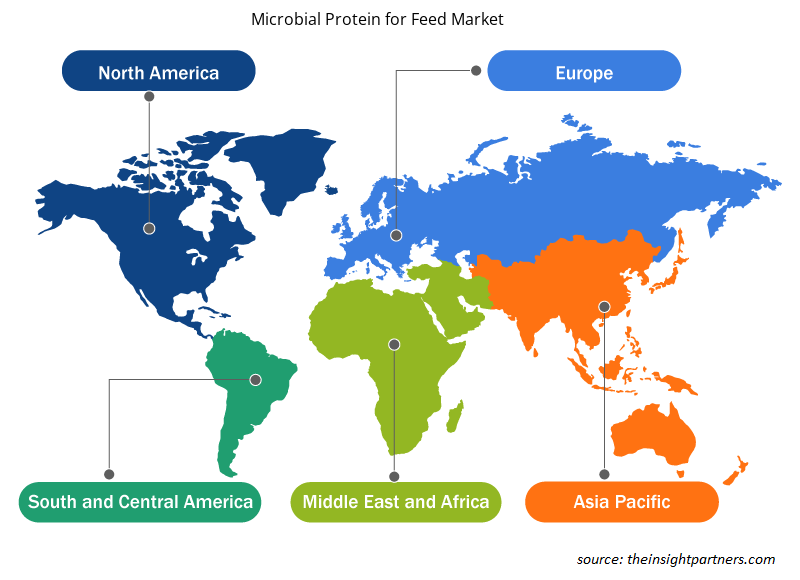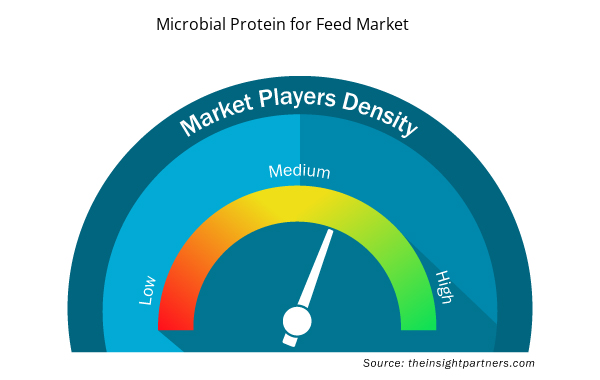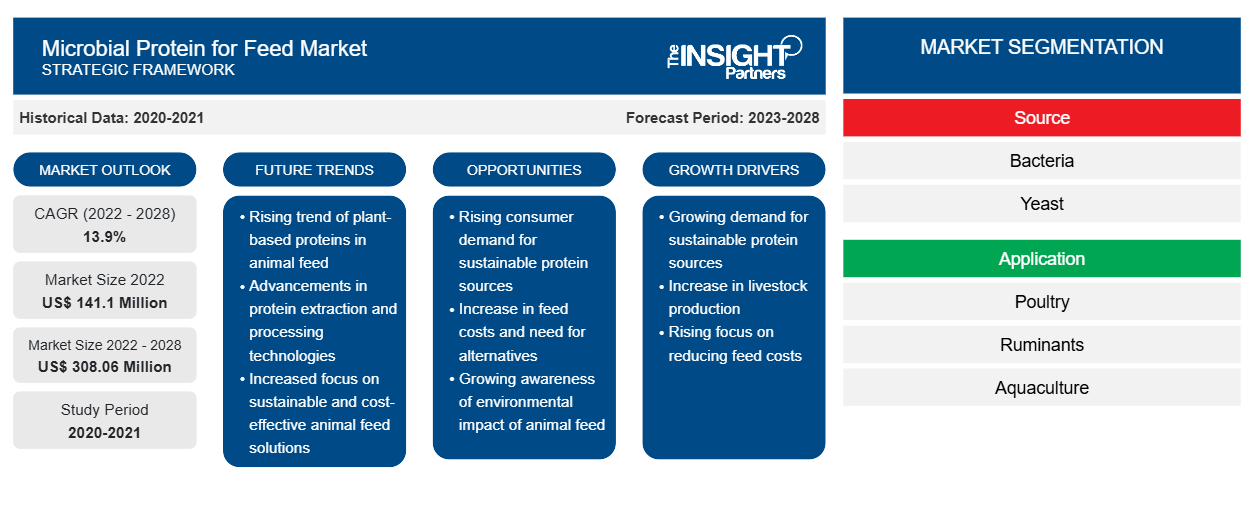من المتوقع أن ينمو حجم سوق البروتين الميكروبي للأعلاف من 141،095.88 ألف دولار أمريكي في عام 2022 إلى 308،055.17 ألف دولار أمريكي بحلول عام 2028؛ ومن المتوقع أن يسجل معدل نمو سنوي مركب بنسبة 13.9٪ من عام 2022 إلى عام 2028.
يعد البروتين الميكروبي أحد المصادر المهمة للبروتين الخام. هناك العديد من الفوائد الغذائية لإدراج البروتين الميكروبي في الأعلاف الحيوانية . يحتوي البروتين الميكروبي على أكثر من 70٪ من البروتين الخام، في حين يحتوي دقيق الصويا على 40-50٪ من البروتين الخام، ويحتوي دقيق السمك على 60-65٪ من البروتين الخام. علاوة على ذلك، فإنه يحتوي على ملف مثالي للأحماض الأمينية، بما في ذلك الفالين الأعلى، والتريبتوفان، والأيزوليوسين، والليوسين مقارنة بوجبات السمك. يعد البروتين الميكروبي أحد البدائل الممتازة للمصادر التقليدية للبروتينات مثل فول الصويا ودقيق السمك. يتم إنتاجه باستخدام ركائز فعالة من حيث التكلفة مثل الغازات الصناعية (ثاني أكسيد الكربون، والميثان، والغاز الطبيعي)، ومياه الصرف الصحي، ونفايات الدواجن (الريش) المخمرة في مفاعل باستخدام البكتيريا أو الخميرة أو الفطريات أو الطحالب الدقيقة. وبالتالي، فإن الفوائد الغذائية المختلفة لإضافة البروتين الميكروبي إلى أنظمة الماشية الغذائية ومخاوف الاستدامة المتزايدة تدفع نمو سوق البروتين الميكروبي للأعلاف .
في عام 2021، استحوذت أوروبا على أكبر حصة من سوق البروتين الميكروبي العالمي للأعلاف. ووفقًا لاتحاد مصنعي الأعلاف الأوروبيين (FEFAC)، زاد إنتاج أعلاف الخنازير بنسبة 2.9٪ في عام 2020، على الرغم من استمرار انتشار حمى الخنازير الأفريقية (ASF) في المنطقة وتأثيرها على تربية الخنازير. زادت العديد من الدول الأوروبية صادراتها إلى الصين، مستفيدة من حظر التصدير في ألمانيا، مما أدى إلى زيادة إنتاج أعلاف الخنازير في عام 2020. مع ارتفاع مستويات إنتاج الأعلاف الحيوانية، يبحث المصنعون عن إضافات أعلاف مستدامة، حيث لا يُنظر إلى إضافات الأعلاف ذات المصدر الحيواني والنباتي على أنها صديقة للبيئة في الوقت الحاضر. تهدد مواد الأعلاف المستوردة، مثل فول الصويا، الموارد الطبيعية والتنوع البيولوجي. وبالتالي، يتزايد الطلب على البروتين الميكروبي بين مصنعي الأعلاف الحيوانية.
قم بتخصيص هذا التقرير ليناسب متطلباتك
ستحصل على تخصيص لأي تقرير - مجانًا - بما في ذلك أجزاء من هذا التقرير، أو تحليل على مستوى الدولة، وحزمة بيانات Excel، بالإضافة إلى الاستفادة من العروض والخصومات الرائعة للشركات الناشئة والجامعات
- احصل على أهم اتجاهات السوق الرئيسية لهذا التقرير.ستتضمن هذه العينة المجانية تحليلاً للبيانات، بدءًا من اتجاهات السوق وحتى التقديرات والتوقعات.
تأثير جائحة كوفيد-19 على سوق البروتين الميكروبي للأعلاف
واجهت صناعة الأعلاف تحديات حاسمة مثل نقص المواد الخام والعمال، وارتفاع أسعار المواد الخام، وانقطاعات شبكات التوزيع بسبب عمليات الإغلاق، وحظر السفر، والقيود التجارية، وإغلاق وحدات التصنيع، وغيرها من القيود التي فرضتها الحكومات في جميع أنحاء العالم. وقد أعاق هذا أنشطة التصنيع لمختلف الشركات في صناعة الأعلاف الحيوانية، مما أدى لاحقًا إلى زيادة أسعار مكونات الأعلاف. في الاتحاد الأوروبي، أشار حوالي ثلثي الدول الأعضاء إلى ارتفاع أسعار الأعلاف في صناعة الثروة الحيوانية أثناء الوباء. علاوة على ذلك، خلال ذروة الوباء، أغلقت الصين أسواق تجارة الماشية والدواجن والذبح في معظم المناطق. أعاقت مثل هذه الحواجز في صناعة الثروة الحيوانية الطلب على مكونات الأعلاف مما كان له تأثير سلبي على الطلب على البروتين الميكروبي للأعلاف أثناء الوباء.
في عام 2021، استأنفت اقتصادات مختلفة عملياتها بعد أن أعلنت حكوماتها تخفيف القيود المفروضة سابقًا، مما عزز السوق العالمية. علاوة على ذلك، سُمح للمصنعين بالعمل بكامل طاقتهم، مما ساعدهم في التغلب على فجوة العرض والطلب وغيرها من التداعيات.
رؤى السوق
استثمارات الحكومة والقطاع الخاص سيكون لها تأثير إيجابي على نمو سوق البروتين الميكروبي للأعلاف
إن تغير المناخ والاستغلال المفرط للموارد الطبيعية مثل الأرض والمياه هي المخاوف الرئيسية المتعلقة بالاستدامة في صناعات الثروة الحيوانية والأعلاف الحيوانية. ونتيجة لذلك، تقوم حكومات مختلف البلدان في جميع أنحاء العالم بتمويل الشركات التي تصنع الأعلاف الحيوانية والمكونات باستخدام ممارسات مستدامة للحد من بصمتها الكربونية الإجمالية ودعم نمو الاقتصاد الدائري. كما تدعم الحكومات والمستثمرون من القطاع الخاص الشركات التي تصنع بروتين الأعلاف الحيوانية من الكائنات الحية الدقيقة لأنها واحدة من أكثر مصادر البروتين استدامة لتغذية الحيوانات. على سبيل المثال، في فبراير 2022، تلقت شركة Arbiom - وهي شركة فرنسية أمريكية لتصنيع البروتينات عالية الجودة لأعلاف الحيوانات وتطبيقات الأغذية من خلال معالجة النفايات الزراعية وبقايا الخشب - استثمارًا بقيمة 13.50 مليون دولار أمريكي من برنامج الاستثمار France Relance. بعد تلقي الاستثمار، أعلنت الشركة عن بناء أول مصنع إنتاج تجاري لها في فرنسا. وبالتالي، من المتوقع أن يؤثر الاستثمار المتزايد من الحكومة والقطاع الخاص في سوق البروتين الميكروبي للأعلاف بشكل إيجابي على نمو السوق خلال الفترة المتوقعة.
رؤى المصدر
بناءً على المصدر، يتم تقسيم سوق البروتين الميكروبي العالمي للأعلاف إلى البكتيريا والخميرة وغيرها. احتل قطاع البكتيريا الحصة الأكبر من سوق البروتين الميكروبي العالمي للأعلاف في عام 2021 ومن المتوقع أن يسجل أعلى معدل نمو سنوي مركب من عام 2022 إلى عام 2028. تظهر البكتيريا أعلى معدلات نمو مقارنة بالخميرة والكائنات الحية الدقيقة الأخرى. علاوة على ذلك، فإن كمية البروتين المنتجة باستخدام الثقافة البكتيرية هي الأكبر. علاوة على ذلك، يحتوي على أكثر من 70٪ من البروتين الخام وله ملف تعريف الأحماض الأمينية الأساسية المواتية. وفقًا لدراسات مختلفة، تنتج 1000 كجم من البكتيريا جودة أعلى من البروتينات من فول الصويا والماشية. وبالتالي، تعد البكتيريا واحدة من المصادر الأكثر فعالية من حيث التكلفة والأسرع للبروتين للأعلاف الحيوانية. كل هذه العوامل تدفع سوق هذا القطاع.
تشمل الجهات الفاعلة الرئيسية العاملة في سوق البروتين الميكروبي العالمي للأعلاف شركة Calysta, Inc.؛ وAvecom؛ وArbiom؛ وKnipBio؛ وICC؛ وAlltech. يركز اللاعبون في السوق على توفير منتجات عالية الجودة لتلبية طلب العملاء. كما يركزون على استراتيجيات مثل الاستثمارات في أنشطة البحث والتطوير والشراكات والتوسع.
البروتين الميكروبي المستخدم في الأعلاف
رؤى إقليمية حول سوق البروتين الميكروبي للأعلاف
لقد قام المحللون في Insight Partners بشرح الاتجاهات والعوامل الإقليمية المؤثرة على سوق البروتين الميكروبي للأعلاف طوال فترة التوقعات بشكل شامل. يناقش هذا القسم أيضًا قطاعات سوق البروتين الميكروبي للأعلاف والجغرافيا في جميع أنحاء أمريكا الشمالية وأوروبا ومنطقة آسيا والمحيط الهادئ والشرق الأوسط وأفريقيا وأمريكا الجنوبية والوسطى.

- احصل على البيانات الإقليمية المحددة لسوق البروتين الميكروبي للأعلاف
نطاق تقرير سوق البروتين الميكروبي للأعلاف
| سمة التقرير | تفاصيل |
|---|---|
| حجم السوق في عام 2022 | 141.1 مليون دولار أمريكي |
| حجم السوق بحلول عام 2028 | 308.06 مليون دولار أمريكي |
| معدل النمو السنوي المركب العالمي (2022 - 2028) | 13.9% |
| البيانات التاريخية | 2020-2021 |
| فترة التنبؤ | 2023-2028 |
| القطاعات المغطاة | حسب المصدر
|
| المناطق والدول المغطاة | أمريكا الشمالية
|
| قادة السوق وملفات تعريف الشركات الرئيسية |
|
كثافة اللاعبين في سوق البروتين الميكروبي للأعلاف: فهم تأثيره على ديناميكيات الأعمال
يشهد سوق البروتين الميكروبي للأعلاف نموًا سريعًا، مدفوعًا بالطلب المتزايد من المستخدم النهائي بسبب عوامل مثل تفضيلات المستهلكين المتطورة والتقدم التكنولوجي والوعي المتزايد بفوائد المنتج. ومع ارتفاع الطلب، تعمل الشركات على توسيع عروضها والابتكار لتلبية احتياجات المستهلكين والاستفادة من الاتجاهات الناشئة، مما يؤدي إلى زيادة نمو السوق.
تشير كثافة اللاعبين في السوق إلى توزيع الشركات أو المؤسسات العاملة في سوق أو صناعة معينة. وهي تشير إلى عدد المنافسين (اللاعبين في السوق) الموجودين في مساحة سوق معينة نسبة إلى حجمها أو قيمتها السوقية الإجمالية.
الشركات الرئيسية العاملة في سوق البروتين الميكروبي للأعلاف هي:
- شركة كاليستا
- افيكوم
- أربيوم
- كنيب بيو
- المحكمة الجنائية الدولية
إخلاء المسؤولية : الشركات المذكورة أعلاه ليست مرتبة بأي ترتيب معين.

- احصل على نظرة عامة على أهم اللاعبين الرئيسيين في سوق البروتين الميكروبي للأعلاف
التطوير الرئيسي:
في يونيو 2022، شكلت شركة Calysta Inc. وAdisseo مشروعًا مشتركًا (JV)، "Calysseo"، لبدء أول منشأة إنتاجية على نطاق صناعي في تشونغتشينغ، الصين، لإنتاج 20 ألف طن من FeedKind، وهو بروتين ميكروبي للأعلاف المائية، سنويًا. مع الإنتاج والتوزيع الناجح لـ FeedKind في الصين، يخطط شركاء المشروع المشترك لتوسيع الطاقة الإنتاجية إلى 80 ألف طن سنويًا في السنوات القادمة.
تقرير يسلط الضوء على
- الاتجاهات الصناعية التقدمية في سوق البروتين الميكروبي للأعلاف لمساعدة اللاعبين على تطوير استراتيجيات فعالة طويلة الأجل
- استراتيجيات نمو الأعمال التي تتبناها البلدان المتقدمة والنامية
- التحليل الكمي لسوق البروتين الميكروبي للأعلاف من 2020 إلى 2028
- تقدير الطلب العالمي على البروتين الميكروبي للأعلاف
- تحليل PEST لتوضيح العوامل السياسية والاقتصادية والاجتماعية والتكنولوجية التي تؤثر على نمو سوق البروتين الميكروبي العالمي للأعلاف.
- التطورات الأخيرة لفهم سيناريو السوق التنافسي
- اتجاهات السوق وتوقعاتها، فضلاً عن العوامل التي تدفع وتكبح نمو سوق البروتين الميكروبي للأعلاف
- المساعدة في عملية اتخاذ القرار من خلال تسليط الضوء على استراتيجيات السوق التي تدعم المصلحة التجارية، مما يؤدي إلى نمو السوق
- حجم سوق منتجات التسمير الذاتي في مختلف العقد
- نظرة عامة مفصلة وتقسيم السوق، بالإضافة إلى ديناميكيات صناعة البروتين الميكروبي للأعلاف
- حجم سوق البروتين الميكروبي للأعلاف في مناطق مختلفة مع فرص نمو واعدة
- التحليل التاريخي (سنتان)، السنة الأساسية، التوقعات (7 سنوات) مع معدل النمو السنوي المركب
- تحليل PEST و SWOT
- حجم السوق والقيمة / الحجم - عالميًا وإقليميًا وقطريًا
- الصناعة والمنافسة
- مجموعة بيانات Excel



Report Coverage
Revenue forecast, Company Analysis, Industry landscape, Growth factors, and Trends

Segment Covered
This text is related
to segments covered.

Regional Scope
North America, Europe, Asia Pacific, Middle East & Africa, South & Central America

Country Scope
This text is related
to country scope.
الأسئلة الشائعة
Rising demand for sustainable feed protein and nutritional benefits of microbial protein over conventional feed protein sources are some of the key driving factors for the microbial protein for feed market.
Based on application, poultry is the fastest-growing segment in the microbial protein for feed market as the demand for poultry meat is growing rapidly with the majority of people preferring chicken over beef and pork due to its low fat and high protein content.
Based on the source, the bacteria segment accounted for the largest revenue share as the bacteria are among the ideal sources for producing microbial protein or single-cell protein (SCP).
Europe accounted for the largest share of the global microbial protein for feed market. With the rising levels of animal feed production, manufacturers are looking for sustainable feed additives, as animal-sourced and plant-sourced feed additives are not perceived as environment-friendly nowadays. Imported feed materials, such as soy, threaten natural resources and biodiversity. Thus, the demand for microbial protein is increasing among animal feed manufacturers in the region.
The major players operating in the global microbial protein for feed market are CALYSTA INC.; Avecom; Arbiom; KnipBio; ICC; and Alltech among few others.
Manufacturers of microbial protein are taking strategic initiatives such as plant capacity expansion and new product development to expand their operations across different geographies is anticipated to create lucrative opportunities for the microbial protein for feed market during the forecast period.
Trends and growth analysis reports related to Food and Beverages : READ MORE..
The List of Companies - Microbial Protein for Feed Market
- CALYSTA INC.
- Avecom
- Arbiom
- KnipBio
- ICC
- Alltech
- Unibio
- Stringbio
- Deep Branch
- EniferBio
The Insight Partners performs research in 4 major stages: Data Collection & Secondary Research, Primary Research, Data Analysis and Data Triangulation & Final Review.
- Data Collection and Secondary Research:
As a market research and consulting firm operating from a decade, we have published and advised several client across the globe. First step for any study will start with an assessment of currently available data and insights from existing reports. Further, historical and current market information is collected from Investor Presentations, Annual Reports, SEC Filings, etc., and other information related to company’s performance and market positioning are gathered from Paid Databases (Factiva, Hoovers, and Reuters) and various other publications available in public domain.
Several associations trade associates, technical forums, institutes, societies and organization are accessed to gain technical as well as market related insights through their publications such as research papers, blogs and press releases related to the studies are referred to get cues about the market. Further, white papers, journals, magazines, and other news articles published in last 3 years are scrutinized and analyzed to understand the current market trends.
- Primary Research:
The primarily interview analysis comprise of data obtained from industry participants interview and answers to survey questions gathered by in-house primary team.
For primary research, interviews are conducted with industry experts/CEOs/Marketing Managers/VPs/Subject Matter Experts from both demand and supply side to get a 360-degree view of the market. The primary team conducts several interviews based on the complexity of the markets to understand the various market trends and dynamics which makes research more credible and precise.
A typical research interview fulfils the following functions:
- Provides first-hand information on the market size, market trends, growth trends, competitive landscape, and outlook
- Validates and strengthens in-house secondary research findings
- Develops the analysis team’s expertise and market understanding
Primary research involves email interactions and telephone interviews for each market, category, segment, and sub-segment across geographies. The participants who typically take part in such a process include, but are not limited to:
- Industry participants: VPs, business development managers, market intelligence managers and national sales managers
- Outside experts: Valuation experts, research analysts and key opinion leaders specializing in the electronics and semiconductor industry.
Below is the breakup of our primary respondents by company, designation, and region:

Once we receive the confirmation from primary research sources or primary respondents, we finalize the base year market estimation and forecast the data as per the macroeconomic and microeconomic factors assessed during data collection.
- Data Analysis:
Once data is validated through both secondary as well as primary respondents, we finalize the market estimations by hypothesis formulation and factor analysis at regional and country level.
- Macro-Economic Factor Analysis:
We analyse macroeconomic indicators such the gross domestic product (GDP), increase in the demand for goods and services across industries, technological advancement, regional economic growth, governmental policies, the influence of COVID-19, PEST analysis, and other aspects. This analysis aids in setting benchmarks for various nations/regions and approximating market splits. Additionally, the general trend of the aforementioned components aid in determining the market's development possibilities.
- Country Level Data:
Various factors that are especially aligned to the country are taken into account to determine the market size for a certain area and country, including the presence of vendors, such as headquarters and offices, the country's GDP, demand patterns, and industry growth. To comprehend the market dynamics for the nation, a number of growth variables, inhibitors, application areas, and current market trends are researched. The aforementioned elements aid in determining the country's overall market's growth potential.
- Company Profile:
The “Table of Contents” is formulated by listing and analyzing more than 25 - 30 companies operating in the market ecosystem across geographies. However, we profile only 10 companies as a standard practice in our syndicate reports. These 10 companies comprise leading, emerging, and regional players. Nonetheless, our analysis is not restricted to the 10 listed companies, we also analyze other companies present in the market to develop a holistic view and understand the prevailing trends. The “Company Profiles” section in the report covers key facts, business description, products & services, financial information, SWOT analysis, and key developments. The financial information presented is extracted from the annual reports and official documents of the publicly listed companies. Upon collecting the information for the sections of respective companies, we verify them via various primary sources and then compile the data in respective company profiles. The company level information helps us in deriving the base number as well as in forecasting the market size.
- Developing Base Number:
Aggregation of sales statistics (2020-2022) and macro-economic factor, and other secondary and primary research insights are utilized to arrive at base number and related market shares for 2022. The data gaps are identified in this step and relevant market data is analyzed, collected from paid primary interviews or databases. On finalizing the base year market size, forecasts are developed on the basis of macro-economic, industry and market growth factors and company level analysis.
- Data Triangulation and Final Review:
The market findings and base year market size calculations are validated from supply as well as demand side. Demand side validations are based on macro-economic factor analysis and benchmarks for respective regions and countries. In case of supply side validations, revenues of major companies are estimated (in case not available) based on industry benchmark, approximate number of employees, product portfolio, and primary interviews revenues are gathered. Further revenue from target product/service segment is assessed to avoid overshooting of market statistics. In case of heavy deviations between supply and demand side values, all thes steps are repeated to achieve synchronization.
We follow an iterative model, wherein we share our research findings with Subject Matter Experts (SME’s) and Key Opinion Leaders (KOLs) until consensus view of the market is not formulated – this model negates any drastic deviation in the opinions of experts. Only validated and universally acceptable research findings are quoted in our reports.
We have important check points that we use to validate our research findings – which we call – data triangulation, where we validate the information, we generate from secondary sources with primary interviews and then we re-validate with our internal data bases and Subject matter experts. This comprehensive model enables us to deliver high quality, reliable data in shortest possible time.


 احصل على عينة مجانية لهذا التقرير
احصل على عينة مجانية لهذا التقرير